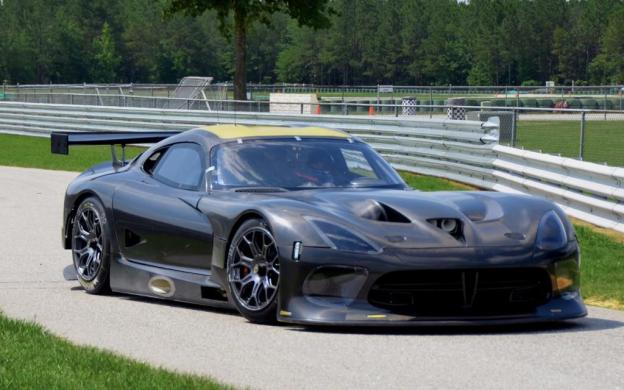 They say racing improves the breed, and that is true of both horses and snakes. The Dodge Viper has a glorious racing history, something Chrysler wanted to continue with the 2013 SRT Viper. The Viper’s caretakers at Chrysler’s Street and Racing Technology Division built the Viper GTS-R to dominate on the track.
They say racing improves the breed, and that is true of both horses and snakes. The Dodge Viper has a glorious racing history, something Chrysler wanted to continue with the 2013 SRT Viper. The Viper’s caretakers at Chrysler’s Street and Racing Technology Division built the Viper GTS-R to dominate on the track.
The SRT Viper GTS-R debuted alongside the street-going Viper at April’s 2012 New York Auto Show, but it won’t turn a wheel in anger until August 4, at the Mid-Ohio Sports Car Challenge. SRT started testing the GTS-R at Mid-Ohio on July 4, so it should be ready.
The Viper GTS-R will compete in the American Le Mans Series (ALMS), with two cars racing a “limited schedule” this year, and competing in all 2013 races. The ALMS features the types of cars that race at the 24 Hours of Le Mans endurance race, divided into two types: prototypes (LMP) and sports cars (GT).
The Viper will be on the same track as exotic prototypes like the Audi R18 e-tron, although due to class rules it will not compete directly against them. Instead, the Viper’s main competition will be other racers based on production cars, including rival Chevrolet’s Corvette.
Racing in ALMS meant SRT had to tailor the Viper GTS-R to that series’ rules. That means, to keep things fair, the racing Viper will actually be less powerful than the street Viper. A stock Viper GTS’ 8.4-liter V10 makes 640 horsepower, but the GTS-R will only put out 450 to 500 hp. However, at 2,745 pounds, the racecar will weigh less than the street car. The GTS-R’s top speed is 180 mph.
Mid-Ohio will not be the Viper’s first race. Viper GTS-Rs won the FIA GT championship in 1997 and 1998. Also in 1998, it placed second at Le Mans, and did the same in 1999 and 2000. That same year, it won the Rolex 24 Hours of Daytona and took the manufacturer’s and driver’s championships in the ALMS GT class.
A few years later, another generation of Viper made its mark on the track. The outgoing 2003-2010 model spawned the Viper Competition Coupe. This most recent Viper racecar won the 2004 Speed World Challenge GT championship and the 2007 and 2008 British GT Championship.
Clearly, the 2013 SRT Viper GTS-R has some big tire tracks to fill. Whether it wins or loses, just building this racer shows SRT’s commitment to making the new Viper a serious performance car in the mold of its predecessors. Maybe some of the knowledge its engineers glean from racing will show up in future Vipers, too.


